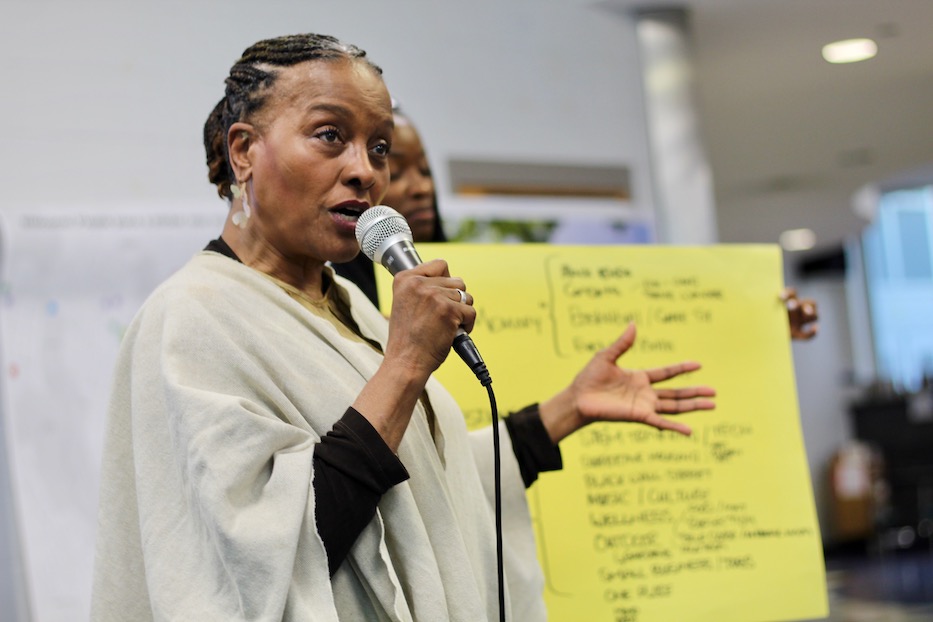
Beaver Hills | Goffe Street Armory | Public art | Arts & Culture | Whalley/Edgewood/Beaver Hills | Arts & Anti-racism | James Hillhouse High School
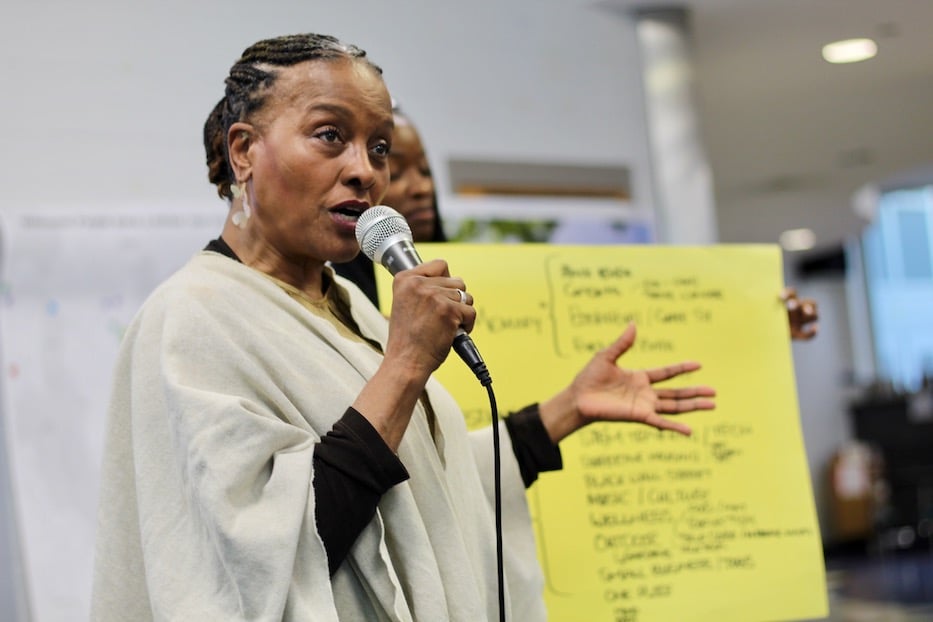
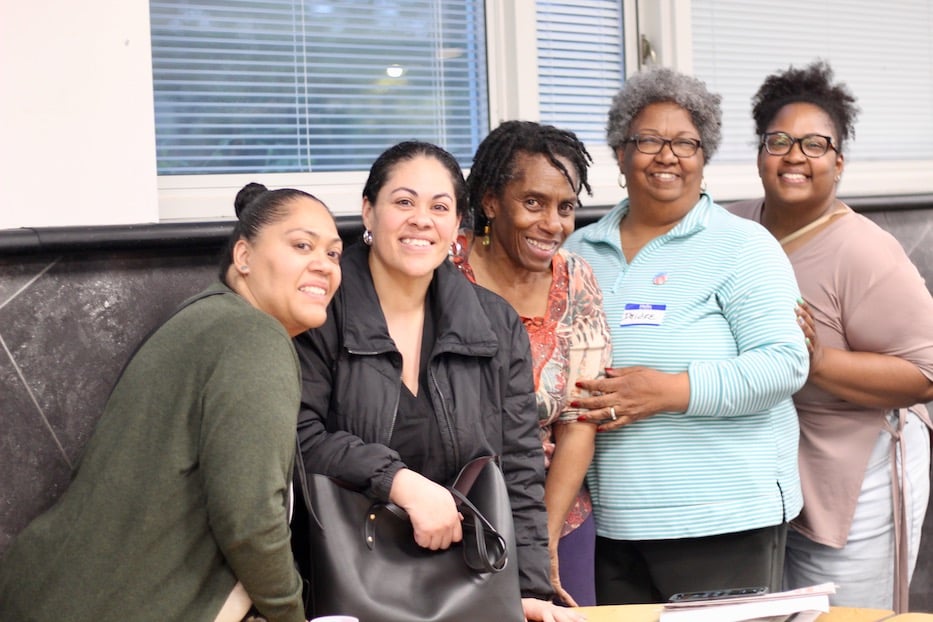
Top: Katurah A. Bryant, founder of The Zola Experience. Bottom: Winthrop Avenue neighbors Alex Taylor-Mendez, Sylvia Taylor, Robin Hobson-Sims, Deidre Moore and her daughter Rebekah Moore. Lucy Gellman Photos.
When Deidre Moore drives past the Goffe Street Armory, she sees more than 155,000 square feet of empty space. Past the soaring walls and overgrown grass, she can envision a center dedicated to prison reentry, a 50-bed homeless shelter, and a drop-in space for youth that is open seven days a week. It will be, once again, “the place to be.”
If she needs to knock on doors, make phone calls, petition city officials and round up neighbors to make it happen, she’s ready to put in the work.
Last Wednesday night, Moore was one of over 100 attendees at a forum to imagine the future of the Goffe Street Armory, a city-owned building at 290 Goffe St. that has been vacant for the better part of two decades. Six years after the building’s last hurrah during City-Wide Open Studios, neighbors, students, city officials and lifelong New Haveners gathered at James Hillhouse High School on Sherman Parkway to imagine the building’s next chapter in New Haven.
“It’s a huge building, and we’d like to see it shine,” Moore said Wednesday, surrounded by Winthrop Avenue neighbors who had come out with her to the event.
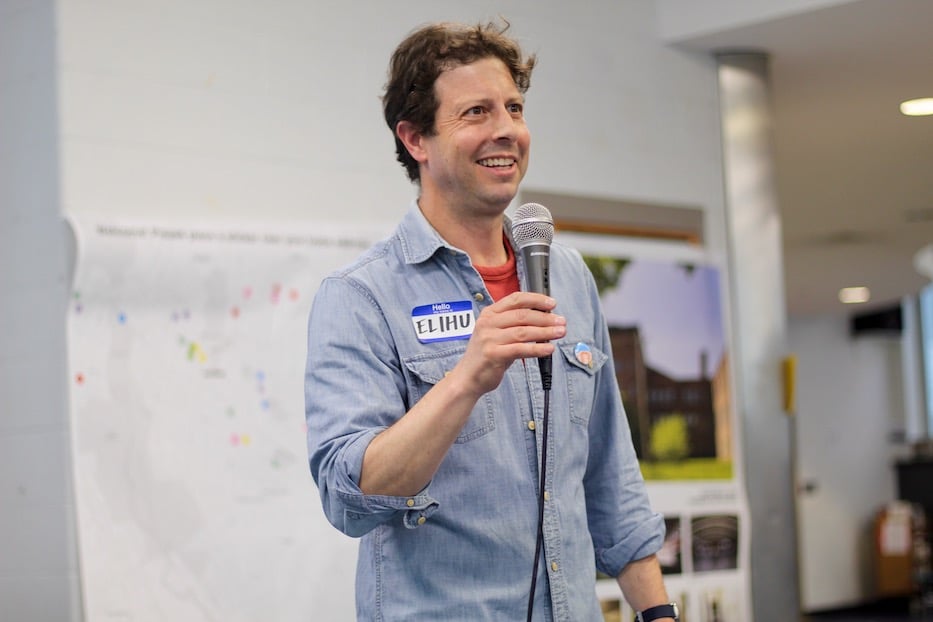
Elihu Rubin.
The project has sprung from a years-long, evolving collaboration among Yale Architecture Professor Elihu Rubin, volunteers at the Armory Community Garden, an Armory Community Advisory Committee and members of the Whalley/Edgewood Beaver Hills Community Management Team. In 2017, Artspace New Haven commissioned “Excavating The Armory,” a project that paired students at New Haven Academy and Yale School of Architecture with each other to research, report on, and dream about the Armory together.
At the time, it was one of 14 special commissions to celebrate City-Wide Open Studios’ (CWOS) two decades in New Haven. When the festival ended and the building again fell silent—thanks partially to a roof on the verge of collapse—Rubin kept that work going. He attended management team meetings and helped out in the garden.
He formed the Armory Community Advisory Committee, then resuscitated it after an unwelcome pandemic pause. In 2021 and again last year, he and garden founder Nadine Horton held meetings on the future of the building. With the help of Kate Cooney, founder of the Inclusive Economic Development Lab at the Yale School of Management, he recruited student researchers to keep uncovering its history, and come up with potential financial models for its future. He started an “Armory Newsprint,” with updates on the space, with the Yale Urban Media Project.
In the past year, he said, he’s also started meeting with city officials and has formed a relationship with Beaver Hills Alder Tom Ficklin, who was present Wednesday night.
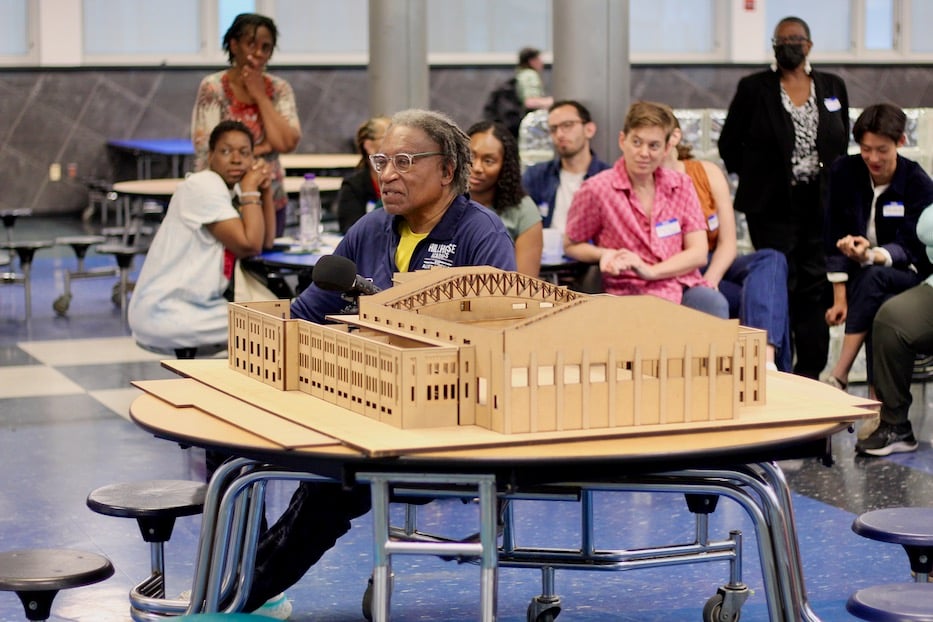
Beaver Hills Alder Tom Ficklin.
It is the latest chapter in the history of a building that is nearly 100 years old. Sitting majestic and empty across the street from the New Haven Correctional Center, the New Haven Armory was first built between 1928 and 1930, as a home to the 102nd Regiment of the Connecticut National Guard.
In the 1970s, it became home to the inaugural Connecticut Black Expo, which it hosted for years before it went on hiatus, then resumed at the Floyd Little Athletic Center. During that time, it also became a site for inaugural balls and city events, memories of which bubbled to the surface many times Wednesday night.
In 2009, the National Guard abandoned the building, and handed it over from the state to the city. At the time, there were murmurs around what to do with the space, from an incubator kitchen to a community center. From 2013 to 2017, Artspace used it every October, for a single weekend of CWOS. Then in 2017, city officials said the roof was too unstable to remain in the space.
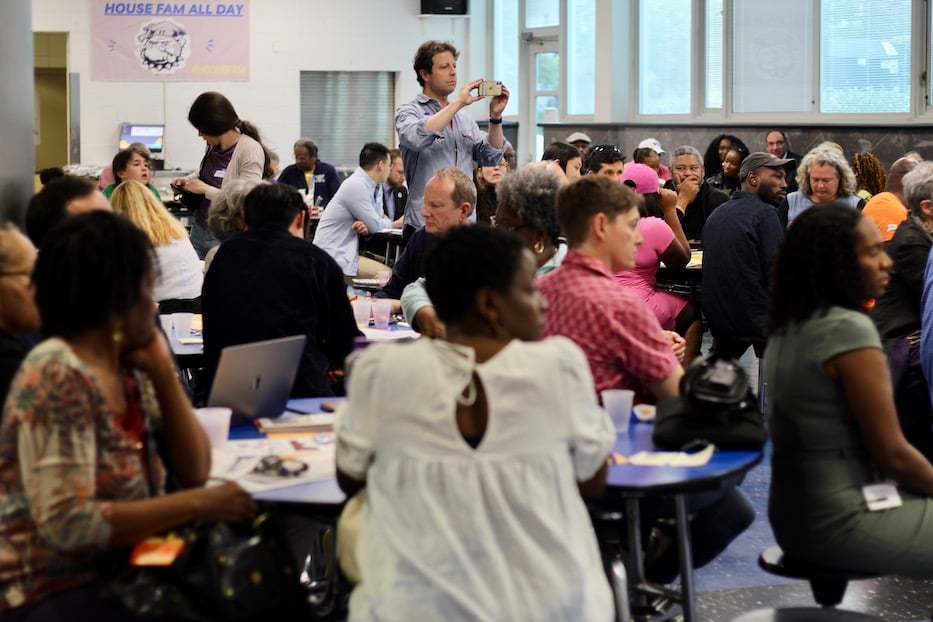
Attendees brainstorming on Wednesday.
Wednesday, City Engineer Giovanni Zinn said that the city is dedicating roughly $100,000 to the roof for patching, waterproofing, and stabilization. The city is working with Eagle Rivet Roof Service Corporation, which began repairs earlier this month.
He added that repairs and updates to the building will likely be much more costly, in the ballpark of millions of dollars. Similar Armory rehabs have ranged from $55 million in Saint Louis to $85.2 million in Jamaica, Queens to $65 million in San Francisco, where a rehab is still unfinished.
He said the city has engaged the Ansonia-based architecture firm AEPM International “to assist with a building assessment and code type study with deliverables expected later this year.”
Seated in Hillhouse’s cafeteria, neighbors added their voices to that dialogue, many bringing their memories of the space with them. As they nibbled on food from Havenly, some spoke of growing up in the neighborhood when the Armory was still in use, and seeing it fall into neglect after 2009. Others said that they’d grown up around the already-vacant Armory, dreaming of what it might be in another life.
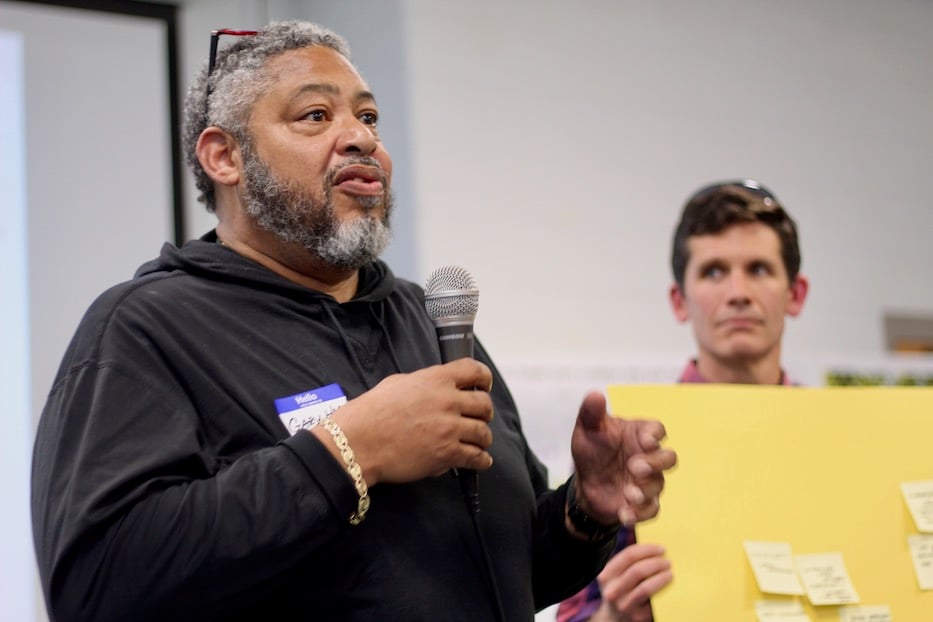
Gary Hogan. Liam Brennan is to his left.
Presenting on behalf of his table, lifelong New Havener and Vice President of Operations at Elm City Communities Gary Hogan noted the need for affordable housing in the neighborhood, and more broadly across the city. Despite the number of new developments popping up around the city, “none of it's affordable for people that really have low income,” he said.
At the new Pierpont Building in the city’s Hill neighborhood, for instance, a one-bedroom apartment costs between $2,300 and $2,700 per month. That’s prohibitive for many of the city’s longtime residents, particularly those looking for space where a family can live.
Because the Armory is so large, he suggested that part of it could be dedicated to housing, while other sections could include a market, food court, and restaurants similar to Colony Square in Midtown Atlanta. For Hogan, it’s personal: he both sees housing as a human right, and grew up close to the Armory on Carmel Street, back when the building was still functional.
Wednesday, he remembered playing in Goffe Street Park and seeing the building in use. “There were a variety of events that would occur, more than just the Black Expo,” he said. Decades later, he thinks about both the sheer cost (he estimated $75 million) and the marketing hurdles to bringing the Armory back.
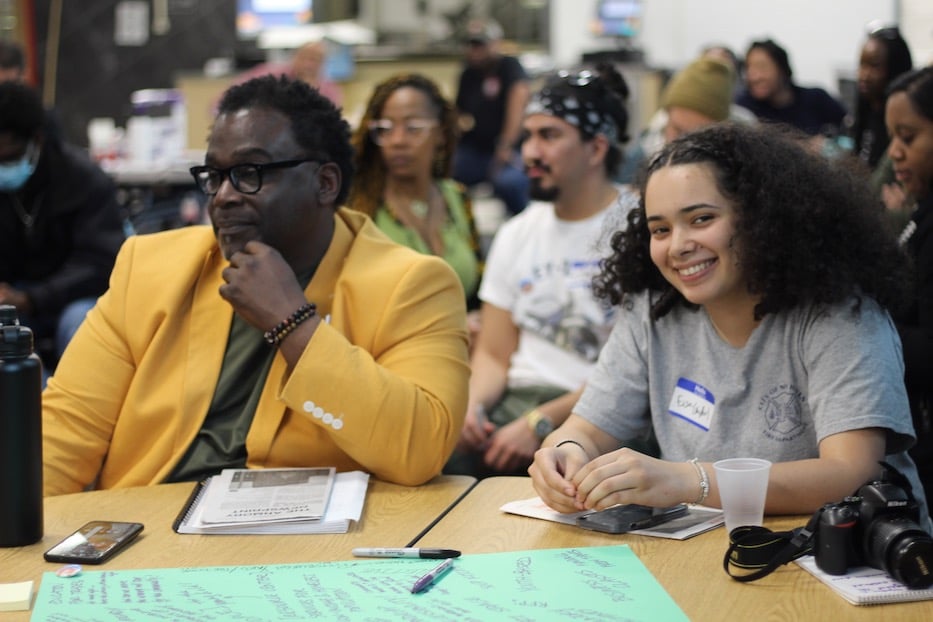
Attendees Steve Driffin and Elsa Holahan. Both are artists and writers; Holahan is a graduating senior at Hillhouse.
“What draws people to the Armory?” he said. “It's got a prison on the backside, it has no parking, it's in a predominantly Black neighborhood—so how will we attract dollars from outside of that community to get past that image?”
Several New Haveners at his table also suggested a youth center like the Dixwell Community Q House they grew up with—an item that received snaps, applause, and several echoes throughout the evening. Currently, the new Q House is operated by Leadership, Education and Athletics in Partnership, Inc. (LEAP), which Hogan said some neighbors see as exclusive and exclusionary. LEAP does offer a series of free classes for the community.
When Hogan was a kid, "it [the Q House] was an after school program and they learned to cut hair, work out, play basketball … whatever it was,” he said. “We want the Armory to be inclusive to all.”
He was one of dozens to propose ideas for the building, which ranged from nonprofit office space to a ghost kitchen to supportive housing for artists and veterans to a marijuana dispensary to New Haven’s first roller rink. Currently, the Armory boasts an open drill hall, surrounded by multiple, labyrinthine floors of rooms that were once offices, locker rooms, an attic and storage spaces. As people spoke, a miniature model peeked out from the front of the room.
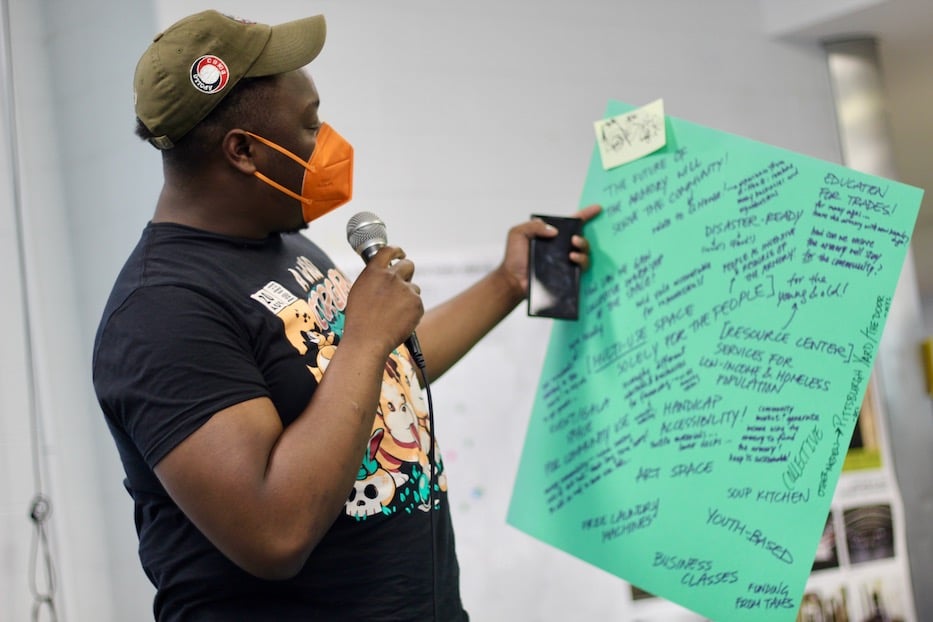
Artist Isaac Bloodworth. Suggestions from his table included a laundromat.
During City-Wide Open Studios, artists turned the rooms into their temporary studio and gallery spaces, with salon-style hangings, full-room installations, and projects that sometimes used the architecture for site-specific art. Since that time, the community garden outside has continued to thrive as the building remains quiet. It is not currently ADA accessible and does not have working heating, ventilation and air conditioning systems (HVAC) or plumbing.
Speaking alongside artist and organizer Hafeeza Turé, the Zola Experience Founder Katurah A. Bryant stressed the need for a large-scale space for healing, from mental wellness to access to fresh, healthy food. For her, that includes an approach focused on the whole person, including safe and secure housing, STEAM education, a self-care and wellness center, options for therapy, and expanded use of the garden supported by federal subsidies.
“We have to talk about things that are self-sustaining,” she said. To that end, she added that she’d heard interest in a small business center and a consistent form of Black Wall Street, or self-sustaining Black business hub, from other attendees at her table. She also suggested moving the correctional facility next door to a different part of the city, an idea that drew applause.
"I don't know if people knew that they had major concerts in there,” Bryant said. “Stevie Wonder was there, we would have the Black Expo, they would have Kool & The Gang, they would have really talented artists. They had major balls there, these fancy shmancy balls where people could get dressed and actually go somewhere. So we asked some questions as to what could be in this building."
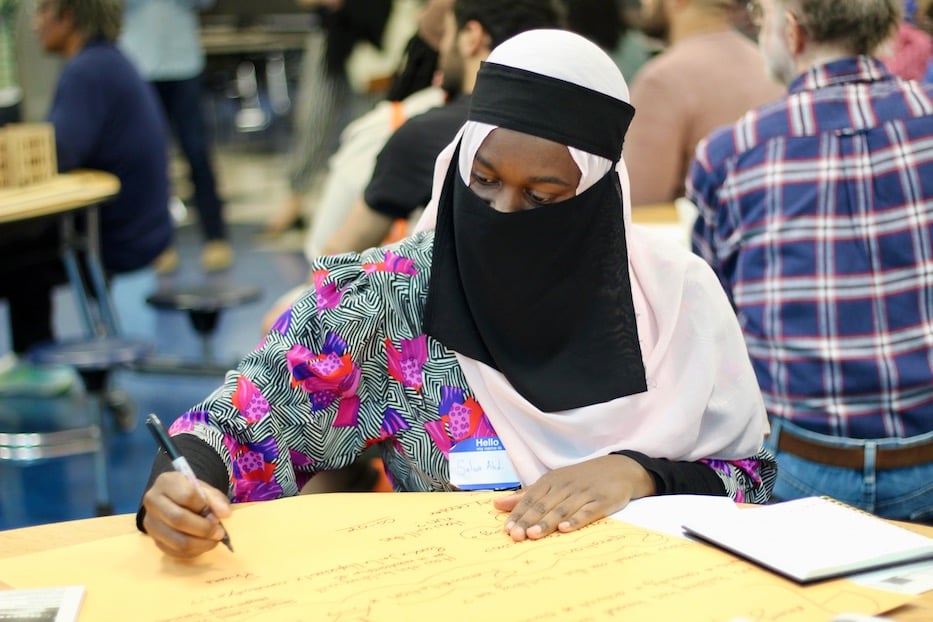
Salwa Abdussabur: "How can we support civic, corporate, and nonprofit?"
Other attendees noted that they’d grown up in the shadow of the Armory after it had shuttered, wondering what might fill the building in the future. Multimedia artist Salwa Abdussabur, who founded the film-focused nonprofit Black Haven three years ago and participated in CWOS with The Word, remembered a childhood in Beaver Hills in which the Armory was a constant and enigmatic fixture.
"I've seen the Armory be so many things,” she said. As an artist and organizer who runs an annual film festival, she noted the ongoing need for free and affordable performance and event space in the city. In years past, she’s had to get creative, using an open parking lot and more recently, the shuttered shell of the old Stetson Branch Library in a midcentury shopping plaza.
“Venue venue venue venue space is something that we are so in dire need for,” she said. She added that she and fellow attendees also see a need for affordable housing, mental and emotional wellness and healing, and reparations in a neighborhood affected by redlining and de facto segregation. The allocation of space is one way to do that.
"The biggest theme, in terms of how to encompass it all, is how can we support civic, corporate, and nonprofit [organizations]?” she said. “This space is so huge that it can accommodate all of the needs of our community.”
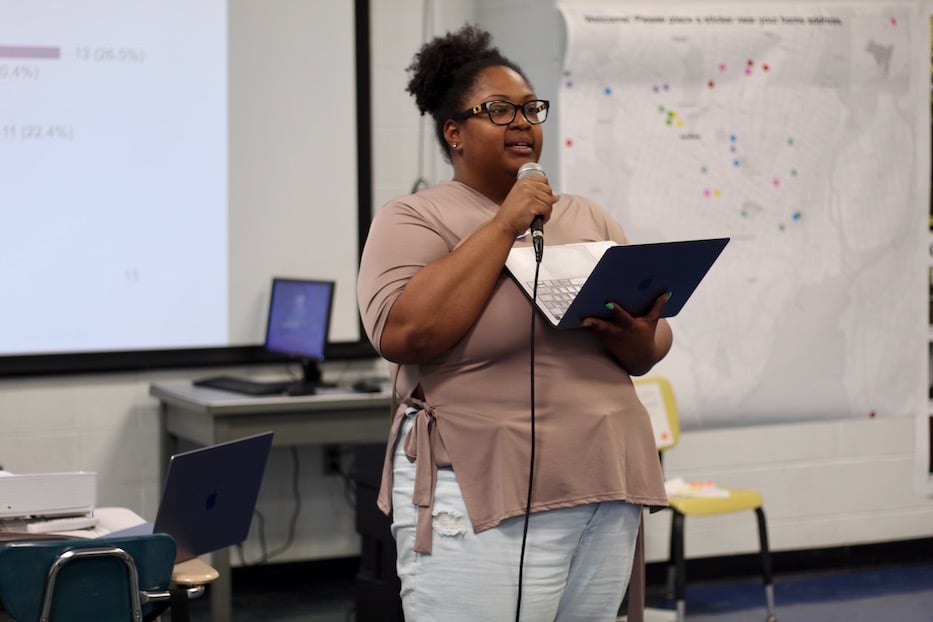
Rebekah Moore. "It's refreshing to hear that everybody in this room has the same idea of what it can be," she said Wednesday.
Some attendees chimed in with staffing questions. Rebekah Moore, a lifelong resident of Beaver Hills who joined her mom Deidre as a facilitator, pointed to the need for a dedicated person to plan, implement, run and supervise programming, similar to her role as program director at the Arts Council of Greater New Haven. Without it, she said, the space can’t operate effectively.
Like her mom, Moore also pointed to the Armory as a potential and much-needed spot for a new homeless shelter and hub for reentry programs, as well as activities for youth. Before she finished speaking, Moore noted that any genuine rehab of the building would have to be a community-wide effort.
"We have to meet the community where they are,” she said. “A lot of people probably couldn't make it today. [We can do this by] knocking on doors, building that relationship first, so that there’s the trust that these ideas that we bring forth will come through."
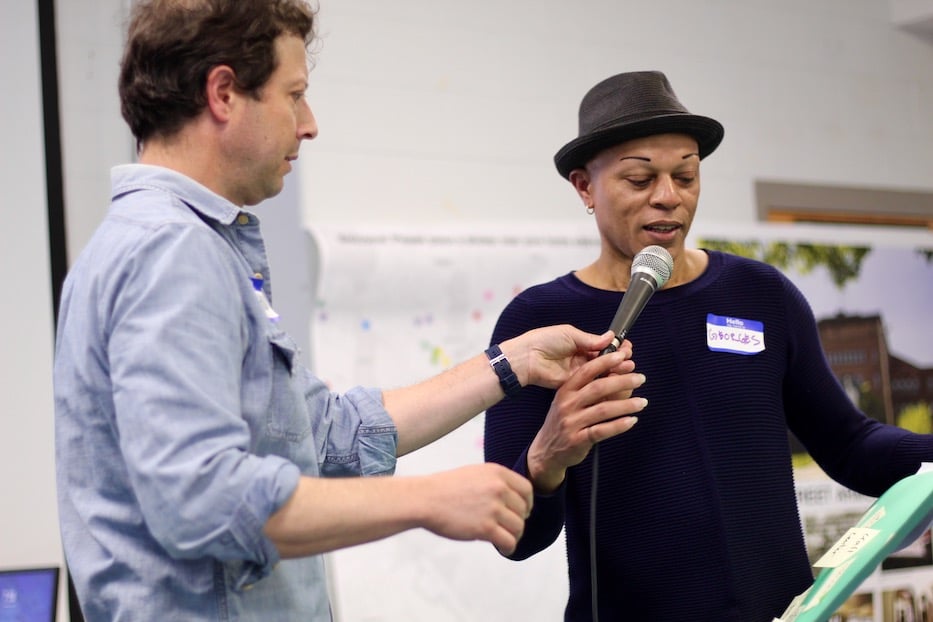
Elihu Rubin and architect Georges Clermont.
A final smattering of ideas focused on both youth and elders. Presenting on behalf of their table, Winthrop Avenue’s Sylvia Taylor and Yale student Edgar Alvarado suggested affordable housing, a roller rink or mini golf, a CrossFit gym that offered one free community option per month—as well as a satellite office of New Haven Reads, for elders who live nearby but cannot make the walk over to the organization’s other sites.
Taylor added that she could envision a hydroponic garden and food market inside. She pointed to EastWorks in East Hampton, Mass., a converted mill that offers residential and office space where artists can work and live.
“We don't have an anchor in our neighborhood,” she said. “So we have a number of different communities, and we don't really interact with each other. So, [let’s] create a place, a location that pulls in everyone so that we all become invested in the community as a whole.”
Even after presentations, the room buzzed with excitement, attendees mingling over what remained of Havenly’s catering spread and tidy triangles of baklava. As it emptied out, Rubin promised that the meeting was just the first step in many discussions around the Armory to come.
Reached by phone after the meeting, he said that he, advisory committee members and city officials plan to hold another forum this summer, focused more closely on financial and organizational models for the space. They do not yet have a date.
“We want to try to put some numbers to this,” he said. “There's only so much from the visioning sessions that can be accomplished. I really do think anything is possible, and it's going to take a little more legwork to mock up the reality of the financing and the partners.”

